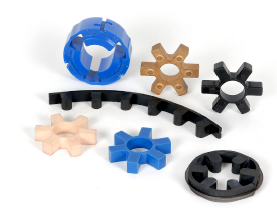Elastomers In Compression
We gives 4 forms of elastomer models to permit for additional versatility in addressing particular application requirements. One particular piece types are used in the “L” and “AL” versions (called spiders) and multiple part “load cushions” are utilized in the “C” and “H” model couplings. The load cushions are in sets of six to 14 pieces dependant upon coupling size.
Reliable Center Spider
The strong center design and style is normally employed style and design when shafts on the driver and driven tools can be stored separate by a typical gap
Open Center Spider
The open center layout allows for the shafts in the driver and driven to get positioned inside a brief distance
Open center spiders supply shaft positioning versatility but possess a decrease RPM capacity
Cushions
Employed solely for that C and H Variety couplings
Load cushions are held in place radially by a steel collar which can be connected to among the hubs
Snap Wrap Versatile Spider
Design and style enables for quick removal of the spider without moving the hubs
Enables  for shut shaft separation every one of the way as much as the hubs optimum bore
for shut shaft separation every one of the way as much as the hubs optimum bore
Highest RPM is one,750 RPM with the retaining ring, but if used together with the LC Sort (with collar) the usual RPM rating on the coupling applies
Fashion is obtainable in NBR and Urethane only, and in limited sizes
Spider Components
SOX (NBR) Rubber
The conventional material that’s hugely versatile material that may be oil resistant
Resembles pure rubber in resilience and elasticity, and operates successfully in temperature ranges of -40° to 212° F (-40° to 100° C)
Urethane
Has one.five times better torque capacity than NBR
Superior resistance to oil and chemical compounds
Material presents less dampening effect and operates at a temperature selection of -30° to 160° F
Hytrel
Flexible elastomer intended for high torque and large temperature operations
Operates in temperatures of -60° to 250° F (-51° to 121° C)
Bronze
Rigid, porous, oil-impregnated metal insert solely for minimal pace (max 250 RPM) applications requiring substantial torque capabilities
Not impacted by water, oil, grime, or severe temperatures – operates in temperatures of -40° to 450° F (-40° to 232° C)